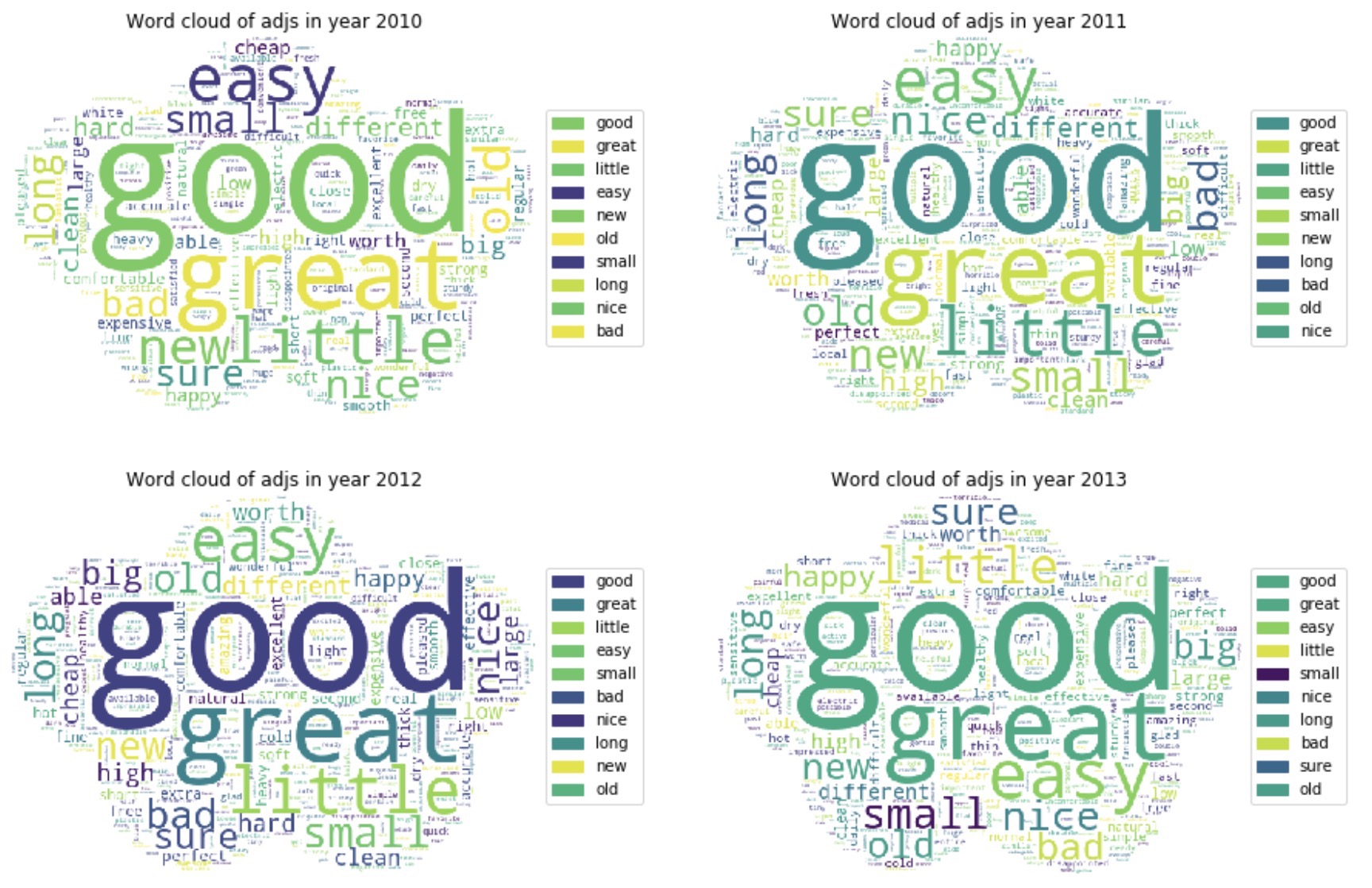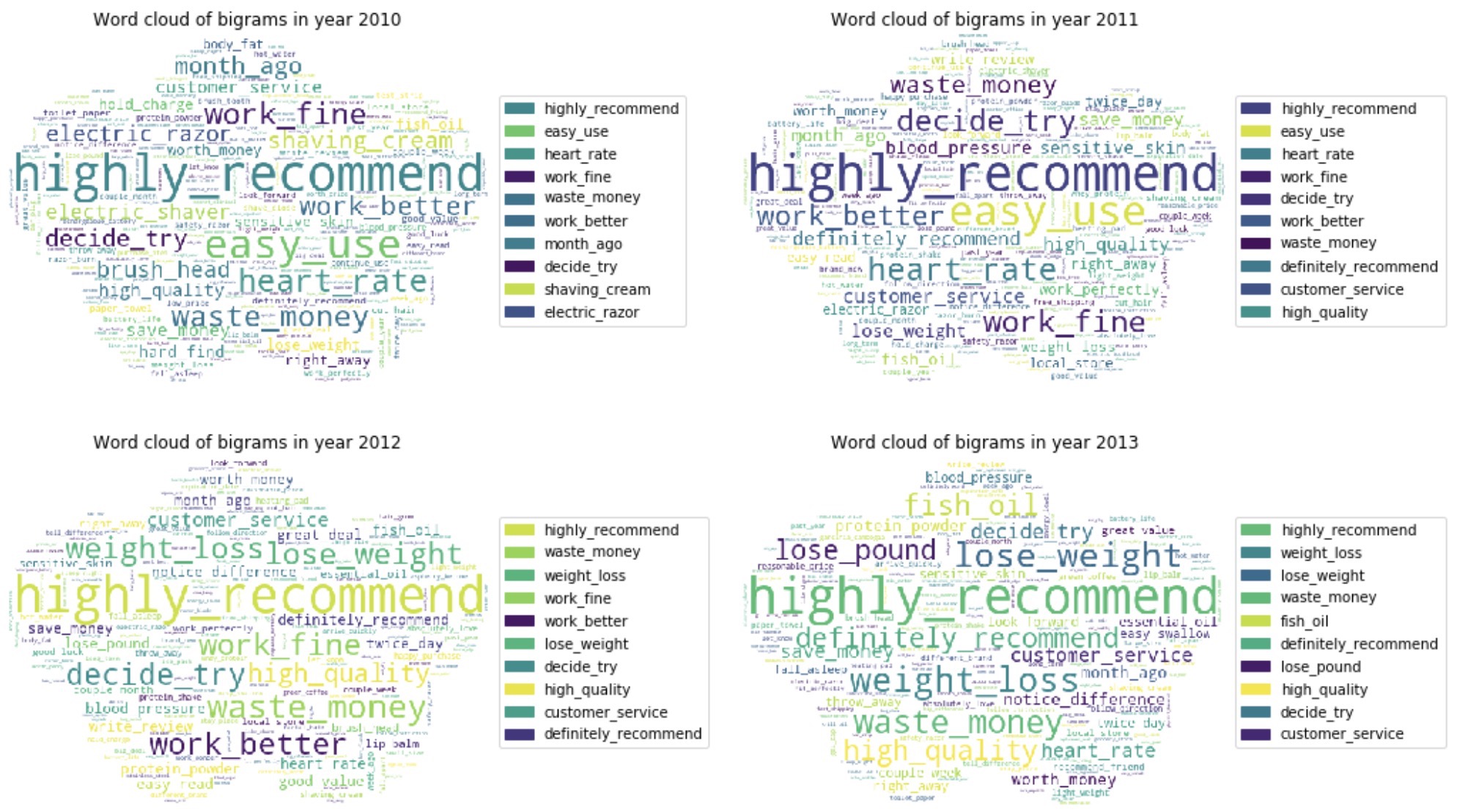Review quantity growth
Popularity is the state or condition of being liked, admired, or supported by many people. The popularity of one product is apparently related to the number of its sales, which is, unfortunately, different from the number of reviews. However, we can intuitively suppose that the number of sales and reviews have a positive correlation, which means the more one product is sold, more reviews it will get. Therefore, to some extent, we can say that the amount of reviews indeed reflects the popularity of products among people.
We visualize the trend of reviews amount of Health Care products per day as below.
Trend of sentiment and key words
However, we will encounter similar problems as we mentioned before: The amount of reviews is only a numerical count which cannot reflect sentiment orientation of the popularity of the product. To get into the depth of trend of popularity, here we analyze the change of sentiment in reviews over years.
Trend of Adjectives Over Years

Trend of Bigrams Over Years

From the year 2010 to 2013, the top 10 keywords of Health Care products in adjectives remain quite stable, in which positive words 'good' and 'great' are dominant and have a much higher probability than the negative word 'bad'. Similarly for bigrams, 'highly recommend', which can naturally be regarded as a positive bigram, always has the highest frequency. So, roughly, we can say that health care products always have a positive evaluation in general and keep popular over these years.
What’s more, we find a phenomenon that 'heart rate' occurs frequently from 2010 to 2011, however, it disappears from top 10 key bigrams and is replaced by 'lose weight' after 2012. Interesting! It seems that people pay more attention to their appearance than before and they are more willing to buy health care products to build a slim figure.
Apparently, the score of Health & Personal Care products keep fluctuating violently in the previous several years, which may indicates that the people’s evaluation and attitude to Health Care products were various and unstable during this period. After 2008, the fluctuation becomes slighter and it seems to go down below 4 during year 2013 and then keep fluctuating up and down within the smaller range from 3.95 to 4, which may be explained that people are more likely to think that Health Care products are generally good but with some small shortcomings.
Seasonal decomposition and special day
Will the popularity of Health Care products be influenced by some specific date? To answer this question, let’s look at the time series decomposition of the data, which decomposes the data into a trend component, a seasonal component and a residual (noise component). Since the amount of reviews is too small before 2004 and the dataset seems not to contain the whole sales data in 2014, we only treat the 2004-2013 interval.
We can observe that there is a seasonal changing pattern of the number of reviews under the yearly growth. The seasonal component starts to grow from November, reaches its peaks around January and then drops, which is, surprisingly, in the Christmas season! It can be seen that special date, especially Christmas, does have an impact on the popularity of Health Care products. We infer that people tend to buy more Health Care products and send them as gifts, which significantly boost consumption. While after Christmas, the need for health care products gradually falls back.
So how does the Christmas season influence the popularity in detail? Let’s go into the deep analysis of Christmas season and see if there is any difference among review quantity, rating, key words and sentiment score compared to values of whole year.
For review quantity of Christmas season, we notice that after 2009, the number of reviews in Christmas season starts to be larger than year’s day average review number and the gap between them is becoming more and more huge as year goes by. We suppose it might because after 2009, with the invention and wide use of smartphones, people are handier to buy products in Amazon using their phones. Another reason might be that the price of Health Care products is always much cheaper online. Especially on Christmas Day, online stores may offer a really excellent discount and significantly boost the sales. Also, in order to celebrate Christmas, the most important day in the year, people may be willing to consume more Health Care product like nutritious food.
The line chart above compares the trend of average rating in Christmas season with that in whole year. During 2004-2009, the average rating in Christmas day fluctuate remarkably, which indicates that people in these year’s Christmas Day take a skeptical attitude toward the healthy product. Sometimes they give a high rating, while sometimes low. However, after 2009, they are more likely to give a good rating for Health Care product on Christmas Day, which probably because the quality of the products are improved under Amazon’s strong supervision.



